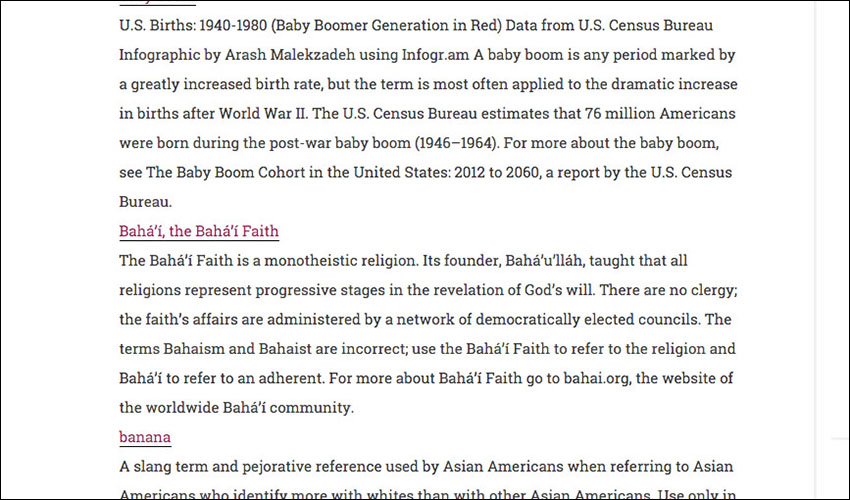Journalism professor creates diversity style guide

The Diversity Style Guide, an online tool created by Associate Professor of Journalism Rachele Kanigel and seen above in a screenshot, is aimed at helping journalists and other media professionals cover a complex, multicultural world with accuracy, authority and sensitivity.
As media outlets worldwide grapple with events and news stories about race, class, the LGBT community and other issues of diversity and inclusion, resources for writers about words and phrases related to demographic groups can be difficult to find.
Rachele Kanigel, an associate professor of journalism at San Francisco State University and a former journalist, is hoping to change that. She has just published a new Diversity Style Guide, available publicly online. A print version, with chapters on covering different communities and issues, is also in production and will be published by Wiley in 2017 or 2018.
The purpose of the guide? To provide reporters and other media professionals such as publicists and marketers with the tools they need to cover a complex, multicultural world in a way that is reflective of the people and events they are writing about.
"There are a lot of terms that people don't know how to use, don't know are pejorative or don't know what they actually mean," Kanigel said. “There are some existing resources, but they’re scattered around the web and many people don’t know where to find them. Bringing them all together in one place helps journalists and media writers write with accuracy and sensitivity."
An earlier version of the guide was written in the 1990s and then posted on the web in 2002 by SF State's Center for Integration and Improvement of Journalism, an organization focused on increasing diversity in the field of journalism. When Kanigel became its interim director in 2013, she decided it was time to update, expand and revitalize the document.
"A lot has changed," Kanigel said. “New terms like Mx., an alternative to Mr. and Ms. for people who don’t identify as male or female; Black Twitter, a virtual community on the Twitter social network that focuses on issues of interest to the Black community; and cisgender, someone whose gender identity aligns with what they were assigned at birth, have come into the lexicon.”
Because the guide lives online, Kanigel hopes journalists and others will provide feedback or suggest additional terms to consider, so she can continually refresh the resource and make sure it is accurate and current. "With the internet, it can be much more of a living, breathing document rather than a PDF that is updated every 10 years or so," she said.
To construct the guide, she began by consulting the style guides of various professional journalism organizations focused on specific demographic groups, such as the Asian American Journalists Association and the National Lesbian and Gay Journalists Association. From there, she broadened her search to include issues beyond those of demographics, such as disability, mental health and drug and alcohol abuse.
"I ended up being in touch with about 20 different organizations and got permission to use material from their style guides," Kanigel said. "Then I found that there were some terms not in any of their style guides but kept coming up, so I started doing research on additional terms." A colleague at SF State, for example, suggested including items related to Japanese immigrants, while a friend suggested including the word "Okies," a term for migrant farm workers, especially Oklahomans, that many do not realize is considered derogatory.
"If people want to be accurate and they want to be writing not just sensitively about different groups but authoritatively, they have to understand the language that they're using and the power of words," she said. "Words have power to tell stories, but they also have power to hurt people and distort the truth of people's experience. If you want to be true to your sources, you need to understand what these terms mean."
Grants from the Sigma Delta Chi Foundation of the Society of Professional Journalists and the College of Liberal and Creative Arts at SF State helped pay for the website and enabled Kanigel to hire several students to help with the project, which she has been working on since early 2014. And throughout the work, she said, being at a university with such a highly diverse student body has been beneficial.
"I love teaching at SF State and I think doing so has helped prepare me for some of the issues that I was writing about in this guide," she said. "San Francisco State is really a microcosm of where the state and nation are going in terms of diversity."
The Diversity Style Guide can be found online at http://www.diversitystyleguide.com.